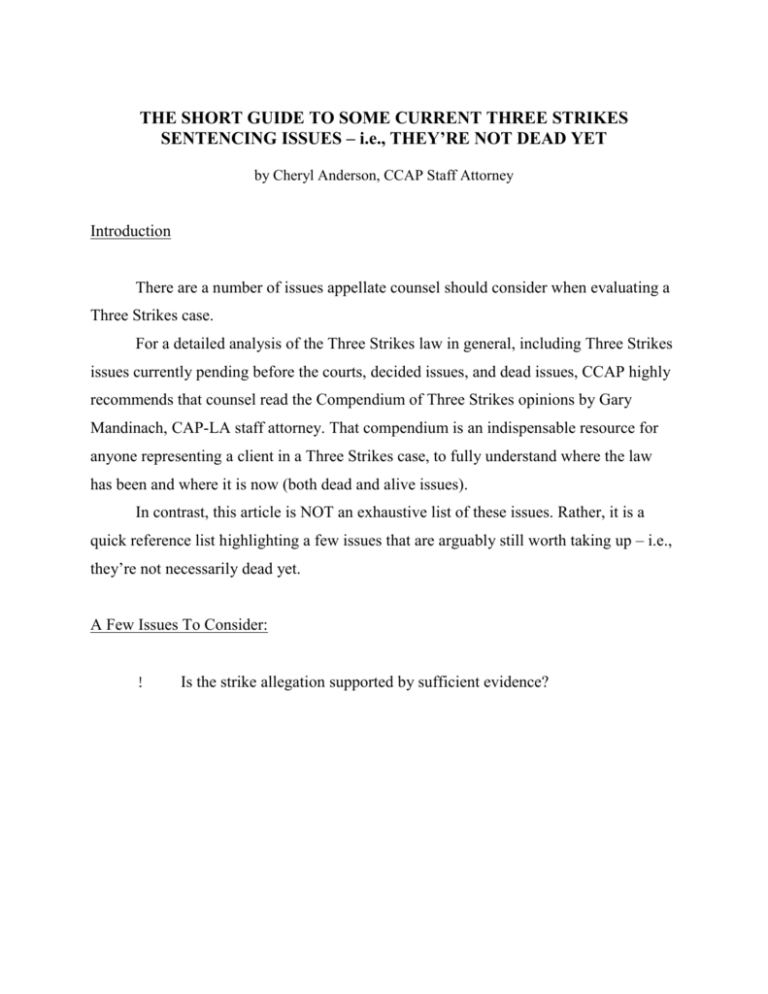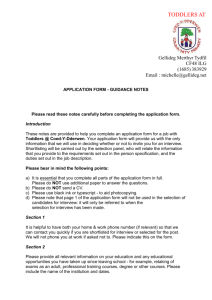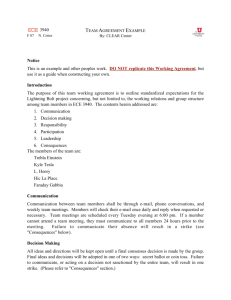THE SHORT GUIDE TO SOME CURRENT THREE STRIKES
advertisement

THE SHORT GUIDE TO SOME CURRENT THREE STRIKES SENTENCING ISSUES – i.e., THEY’RE NOT DEAD YET by Cheryl Anderson, CCAP Staff Attorney Introduction There are a number of issues appellate counsel should consider when evaluating a Three Strikes case. For a detailed analysis of the Three Strikes law in general, including Three Strikes issues currently pending before the courts, decided issues, and dead issues, CCAP highly recommends that counsel read the Compendium of Three Strikes opinions by Gary Mandinach, CAP-LA staff attorney. That compendium is an indispensable resource for anyone representing a client in a Three Strikes case, to fully understand where the law has been and where it is now (both dead and alive issues). In contrast, this article is NOT an exhaustive list of these issues. Rather, it is a quick reference list highlighting a few issues that are arguably still worth taking up – i.e., they’re not necessarily dead yet. A Few Issues To Consider: ! Is the strike allegation supported by sufficient evidence? People v. Guerrero (1988) 44 Cal.3d 343 is the controlling case in California on the evidence that may be used to prove a prior-conviction allegation. In Guerrero, the California Supreme court held that the trier of fact may consider “the entire record of conviction” (if otherwise admissible under the rules of evidence) in order to determine “the substance of a prior conviction,” i.e., “the facts of the offense actually committed.” But see “Jabs” And “Upper” 2 This Resource provided by WWW.CAPCENTRAL.ORG Article Originally posted at: http://www.capcentral.org/resources/criminal/threestrikes_addendum.aspx Cuts, Shephard v. United States, and An Approach to Understanding and Applying Blakely v. Washington to Sentencing Determinations in California, authored by CCAP staff attorney, Bill Arzbaecher, which discusses how the Supreme Court’s opinions in Jones (Jones v. United States (1999) 526 U.S. 227), Apprendi (Apprendi v. New Jersey (2000) 530 U.S. 466), Blakely (Blakely v. Washington (2004) 542 U.S. 296), Shepard (Shepard v. United States (2005) __ U.S. __ [125 S.Ct. 1254; 161 L.Ed.2d 205] (collectively referred to a “JABS”) substantially impact and call into question the continuing validity of Guerrero. As explained in that article, by clarifying what a “conviction” is, JABS have also clarified what a “prior conviction” is, for purposes of the United States Constitution. JABS instruct that a “conviction” consists of the facts for which the defendant may constitutionally be punished, and these are limited to the facts actually adjudicated, i.e., the facts found true by the jury or admitted by the defendant. Guerrero is inconsistent with this teaching, because it suggests that the entire record of conviction – including the conduct underlying it – may be considered. This violates the constitutional rationale underpinning of JABS. ! If not supported by sufficient evidence, may the prior be remanded for retrial without violating double jeopardy? In People v. Monge (1997) 16 Cal.4th 826 (“Monge I) and Monge v. California (1998) 524 U.S. 721 [141 L.Ed.2d 615, 118 S.Ct. 2246] (“Monge II”), the state and federal Supreme Courts held that the trial of a prior conviction alleged under the Three Strikes law is a mere “sentencing proceeding” to which Double Jeopardy’s multiple-prosecution bar does not apply. But see “JABS”and “Upper” Cuts which also discusses how the Supreme Court’s opinions in JABS substantially impact and call into question the continuing validity of Monge I and II. This Resource provided by WWW.CAPCENTRAL.ORG Article Originally posted at: http://www.capcentral.org/resources/criminal/threestrikes_addendum.aspx As explained in the article, in Apprendi and Jones, the United States Supreme Court held that the elements of a crime – the facts that must be submitted to the jury and proved beyond a reasonable doubt – include any fact, other than the fact of a prior conviction, that increases the maximum penalty for the crime. By extending the right to a jury trial to the facts legally essential to a defendant’s sentence, JABS have also extended our doublejeopardy rights to such facts. ! Did the judge or jurors determine the prior conviction is a serious or violent felony? ! Did the judge or jurors determine the identity of the person who suffered the prior conviction? In People v. Kelii (1999) 21 Cal.4th 197, the California Supreme Court held that the court and not the jury is to determine whether a prior conviction is a serious or violent felony. And, pursuant to Penal Code section 1025, subdivision (c), “the question of whether or not the defendant is the person who has suffered the prior conviction shall be tried by the court without a jury.” Further in Almendarez-Torres v. United States (1998) 523 U.S. 224 [140 L.Ed.2d 350, 523 U.S. 224], the Court held that a prior conviction that increases the defendant’s sentence may constitutionally be treated as a sentencing factor that may be decided by a judge and need not be set forth in an indictment. See “JABS” and “Upper” Cuts which discusses the fact that Almendarez-Torres and the “fact of a prior conviction” exception are now hanging by a thread. See also Shepard v. United States, supra, which discusses the need to challenge the continuing validity of Almendarez-Torres and of the California statutory and case authority that deprives defendants of the right to a jury trial – and to not true findings in the absence of jury findings beyond a reasonable doubt – on all facts required to impose a prior conviction based enhancement. This Resource provided by WWW.CAPCENTRAL.ORG Article Originally posted at: http://www.capcentral.org/resources/criminal/threestrikes_addendum.aspx ! Was the prior conviction alleged a juvenile adjudication? In People v. Garcia (1999) 21 Cal.4th 1, the California Supreme Court held that a juvenile adjudication can qualify as a strike if: (1) it is listed in Welfare and Institutions Code section 707, subdivision (b); or (2) if it is listed as in Penal Code section 667, subdivision (c), or as a serious felony in Penal Code section 1192.7, subdivision (c), and if it was adjudicated as part of a petition in which the minor was found to have committed any offense listed in Welfare and Institutions Code section 707, subdivision (b). However, see “JABS” and “Upper” Cuts, supra, which discusses the need for defense counsel to challenge juvenile adjudications alleged as strikes or “recidivist” priors on the ground that juveniles have no right to a jury trial, so prior juvenile adjudications should not fall within the “fact of a prior conviction” exception to Apprendi. ! Is it an appropriate case to mount a cruel and unusual punishment challenge? The trend in federal and state courts has been to reject cruel or unusual challenges to California’s Three Strikes law. For example, in Ewing v. California (2003) 538 U.S. 11 [155 L.Ed.2d 108, 123 S.Ct. 1179], the Supreme Court held the imposition of a potential life sentence for a defendant who has a lengthy felony and misdemeanor record and qualifying strikes did not constitute cruel or unusual punishment, even though the current offense was for theft of golf clubs valued near $1,200. In Lockyer v. Andrade (2003) 538 U.S. 63 [155 L.Ed.2d 144, 123 S.Ct. 1166], the Court held a potential life sentence for a repeat offender, whose past convictions were for serious crimes and whose new triggering offense was petty theft, did not constitute cruel or unusual punishment. On the state court side, for example, in People v. Meeks (2004) 117 Cal.App.4th 891, the Third This Resource provided by WWW.CAPCENTRAL.ORG Article Originally posted at: http://www.capcentral.org/resources/criminal/threestrikes_addendum.aspx District Court of Appeal held, over strong dissent, that the Three Strike sentence of 25 years to life for failing to register after change of address did not constitute cruel or unusual punishment under the state or federal constitutions, given the seriousness of the crime and the defendant’s prior criminal history. However, there have been a few encouraging Eighth Amendment developments which nonetheless demonstrate the need for counsel, in appropriate cases, to continue challenging California’s Three Strikes law as cruel or unusual punishment under the state and federal constitutions. For example, in Ramirez v. Castro (9th Cir. 2004) 365 F.3d 755, the Ninth Circuit found a California state habeas petitioner’s Three Strikes sentence of 25-years-to-life for stealing a $200 VCR to be “grossly disproportionate” to his criminal culpability, given that he surrendered without resistance and his only two prior convictions were for nonviolent robberies involving no weapons. And in People v. Carmony (2005) 127 Cal.App.4th 1066, the Third District Court of Appeal found a severe sentence for a technical sex-registration violation to be cruel and unusual punishment under both the state and federal constitutions. For a more detailed discussion of Carmony and its implications, see Carmony Sentence Cruel & Unusual Punishment, authored by CCAP staff attorney, John Hargreaves. Caveat The foregoing is meant to serve as merely a starting point for evaluating and analyzing some current Three Strikes issues worth taking up. Counsel should also consult the more in-depth Three Strikes compendium and, as always, do his/her own independent research of current and developing Three Strikes sentencing issues.





